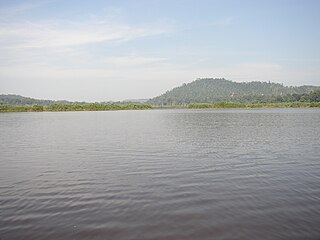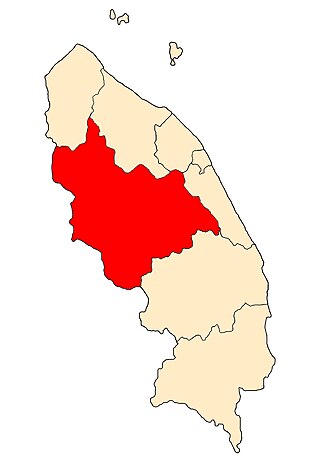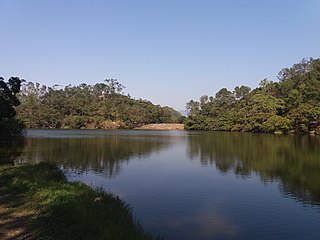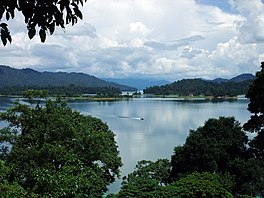
Terengganu, formerly spelled Trengganu or Tringganu, is a sultanate and federal state of Malaysia. The state is also known by its Arabic honorific, Dāru l-Īmān. The coastal city of Kuala Terengganu, which stands at the mouth of the broad Terengganu River, is both the state and royal capital as well as the largest city in Terengganu. Other major cities and towns includes Jerteh, Kuala Dungun, Chukai, Kuala Berang, Marang, and Permaisuri. At 13,035 square kilometres in size and a population of around 1.14 million people, Terengganu is Malaysia's 7th largest state by area and 10th largest in population. Terengganu, along with Kelantan, Perlis and the Federal Territory of Putrajaya is one of the most homogeneous states/territories in the country of which 95% of the population are ethnic Malay-Muslims with its own distinct language/dialect, culture, history and tradition.

The barramundi, Asian sea bass, or giant sea perch, or dangri is a species of catadromous fish in the family Latidae of the order Perciformes. The species is widely distributed in the Indo-West Pacific, spanning the waters of the Middle East, South Asia, Southeast Asia, East Asia, and Oceania.

Taman Negara is a national park in Peninsular Malaysia. It was established in 1938/1939 as the King George V National Park after Theodore Hubback lobbied the sultans of Pahang, Terengganu and Kelantan to set aside a piece of land that covers the three states for the creation of a protected area. It was renamed Taman Negara after independence, which means "national park" in Malay. Taman Negara has a total area of 4,343 km2 and it is one of the world's oldest deciduous rainforests, estimated to be more than 130 million years old.

The arapaima, pirarucu, or paiche is any large species of bonytongue in the genus Arapaima native to the Amazon and Essequibo basins of South America. Arapaima is the type genus of the subfamily Arapaiminae within the family Osteoglossidae. They are among the world's largest freshwater fish, reaching as much as 3 m (9.8 ft) in length. They are an important food fish. They have declined in the native range due to overfishing and habitat loss. In contrast, arapaima have been introduced to several tropical regions outside the native range, where they are sometimes considered invasive species. In Kerala, India, arapaima escaped from aquaculture ponds after floods in 2018. Its Portuguese name, pirarucu, derives from the Tupi language words pira and urucum, meaning "red fish".

Chilika Lake is the largest brackish water lagoon in Asia and second largest coastal lagoon in the world, spread over the Puri, Khordha and Ganjam districts of Odisha state on the east coast of India, at the mouth of the Daya River, flowing into the Bay of Bengal, covering an area of over 1,100 square kilometres (420 sq mi). Another lake in India called Vembanad Lake is the longest lake in India. Chilika Lake comes after the New Caledonian barrier reef. It has been listed as a tentative UNESCO World Heritage site. Its salinity varies by region, from nearly freshwater where rivers flow in, to oceanic salinity levels due to tidal influx.

Chini Lake is a lake in Pekan District, Pahang, Malaysia. The lake shores are inhabited by the Jakun branch of the Orang Asli.

Golfo Dulce is a gulf in Costa Rica, located at the south of the Province of Puntarenas. The inlet starts on the Pacific Ocean side of Costa Rica and extends slightly northward before turning west. The most westward part is at the city of Rincon. The bay separates the Osa Peninsula from the mainland Costa Rica.

Hulu Terengganu is an interior district of Terengganu, Malaysia. The seat of the district is Kuala Berang, located about 40 km (25 mi) from the state capital, Kuala Terengganu. The local government of this district is Hulu Terengganu District Council.
Sultan Mahmud Power Station or Kenyir Dam is the hydroelectric dam which forms Kenyir Lake, Terengganu, Malaysia. It is located 50 km southwest of Kuala Terengganu on the Kenyir River. The project is a multipurpose hydroelectric power and flood mitigation scheme.

Temenggor Lake is a lake in Hulu Perak District, Perak, Malaysia. It is the second largest lake in Peninsular Malaysia after Kenyir Lake in Hulu Terengganu District, Terengganu. This man-made lake is located south of 1,533 m high Ulu Titi Basah peak. It was created after the construction of Temenggor Dam to generate electric power. The lake is located about 45 km from the Hulu Perak district capital, Gerik. There is a man-made island, Banding Island and Lake Temenggor Bridge on the East-West Highway which crosses the lake.

Maharana Pratap Sagar, also known as Pong Reservoir or Pong Dam Lake is a large reservoir in Fatehpur, Jawali and Dehra tehsil of Kangra district of the state of Himachal Pradesh in India. It was created in 1975, by building the highest earthfill dam in India on the Beas River in the wetland zone of the Siwalik Hills. Named in the honour of Maharana Pratap (1540–1597), the reservoir or the lake is a well-known wildlife sanctuary and one of the 49 international wetland sites declared in India by the Ramsar Convention. The reservoir covers an area of 24,529 hectares, and the wetlands portion is 15,662 hectares.

Dipor Bil, also spelled Deepor Beel , is located to the south-west of Guwahati city, in Kamrup Metropolitan district of Assam, India. It is a permanent freshwater lake, in a former channel of the Brahmaputra River, to the south of the main river. In 1989, 4.1 km² of the area was declared a wildlife sanctuary by the Government of Assam. It is listed as a wetland under the Ramsar Convention which designated the lake as a Ramsar Site in November 2002 for undertaking conservation measures on the basis of its biological and environmental importance.

The Jullien's golden carp is a species of endangered freshwater ray-finned fish in the family Cyprinidae found in Southeast Asian river basins. Its existence is being threatened by various economic activities, such as large-scale agriculture and the building of dams for hydropower.

Catemaco Municipality is a municipality in the Mexican state of Veracruz. It is located in the state's Los Tuxtlas region. The municipal seat is the city of Catemaco.
The Hulu Terengganu Hydroelectric Project is an underground hydroelectric power plant located the Terengganu, Malaysia. It was built from 2010 to 2015 by Tenaga Nasional Berhad, the largest electricity utility company in Malaysia.
Tasik Biru Seri Kundang is a recreational lake located at Kampung Melayu Sri Kundang, Rawang, Selangor, Malaysia, a village near to Sungai Buloh. It is an ex-mining lake that used to be developed long time ago during the British colonial time. During its olden days, the lake was used to be the biggest mining area in Rawang district, and one of the biggest in Selangor as well. It is about 25 km to the north from Kuala Lumpur.
Setiu Wetlands is a wetland in Setiu District, Terengganu, Malaysia. It is part of the Setiu River basin, and also of the larger Setiu-Chalok-Bari-Merang basin wetland complex. With a size of 23,000 hectares, Setiu Wetlands is the largest natural wetlands in the East Coast region of Peninsular Malaysia, combining various ecosystems including freshwater, seawater, brackish water and a 14 km lagoon.
The Lake Tana Biosphere Reserve is a protected area located in the Amhara National Regional State approximately 563 km northwest of Addis Ababa in the north-western part of Ethiopia. The biosphere reserve comprises Lake Tana, the largest lake in Ethiopia, the main source of the Blue Nile, which provides important ecosystem services. The area is a hotspot of biodiversity, internationally known as an Important Bird Area and is of global importance for agricultural genetic diversity. The area is characterized by an enormous heterogeneity of land uses and natural ecosystems.

Lau Shui Heung Reservoir, built in 1968 as part of the Plover Cove Reservoir engineering programme, is a reservoir located within the boundary of Pat Sin Leng Country Park in the eastern part of North District, New Territories, Hong Kong, located at the northeast area of Bird's Hill, at the northeast end of Sheung Shui-Fanling Plain. It covers an area of 3.5 hectares and a water storage capacity of 170,000 m3. It is responsible for collecting water from the northwestern part of Pat Sin Leng and supplying it to the Plover Cove Reservoir through a water conveyance tunnel, while Lau Shui Heung Reservoir is an irrigation reservoir used to irrigate nearby farmland. The Lau Shui Heung Country Trail passes through the reservoir. The main concrete dam is 24 m high and 54.9 m long, the secondary dam is 7.3 m high and 39 m long and the scale of the reservoir is small. The reservoir is the main source of Kwan Tei River, and the water from the reservoir flows into Kwan Tei and then the Ng Tung River.
Taman Tasik Shah Alam, also known as Shah Alam Lake Garden, is a 43-hectare public park located in Shah Alam, Selangor, Malaysia. It is the first public park to open in the state of Selangor in 1985 and designed by architect Fumiaki Takano. The park is home to three man-made lakes, which are connected by a network of canals and walkways. There is also a water theme park, Wet World Shah Alam, located on the Western Lake. The park hosts a variety of flora and fauna. There are over 100 species of trees and plants, as well as a variety of birds, animals, and insects.

















